When to see the Great Migration in Africa?
Every year, the plains of East Africa become the stage for one of the greatest wildlife shows on Earth: The Great Migration. Over 1.5 million wildebeest, along with hundreds of thousands of zebras and gazelle, travel in a vast circle across the Serengeti in Tanzania and the Masai Mara in Kenya.
With the herds come the hunters—lions, cheetahs, hyenas, and crocodiles—all waiting for their chance at an easy meal. For safari travelers, this is nature at its most raw and unforgettable. You’ll see moments of danger, moments of tenderness, and scenes that feel like they’re straight out of a documentary.
The Great Migration is not a single event but a year-round cycle. There is no single “best” time to see it—the best time depends on what you want to experience: Want drama? Visit during the river crossings in the north. Want new life? Travel during calving season in the south. Want sheer scale? Witness endless columns of wildebeest moving through the central Serengeti.
Think of the migration as having four main seasons, each with its own highlights. For more detail, explore our month-by-month guide below—from newborn calves taking their first steps to heart-stopping scenes of wildebeest leaping into crocodile-filled rivers. No matter when you go, the Great Migration will leave you with memories to last a lifetime.
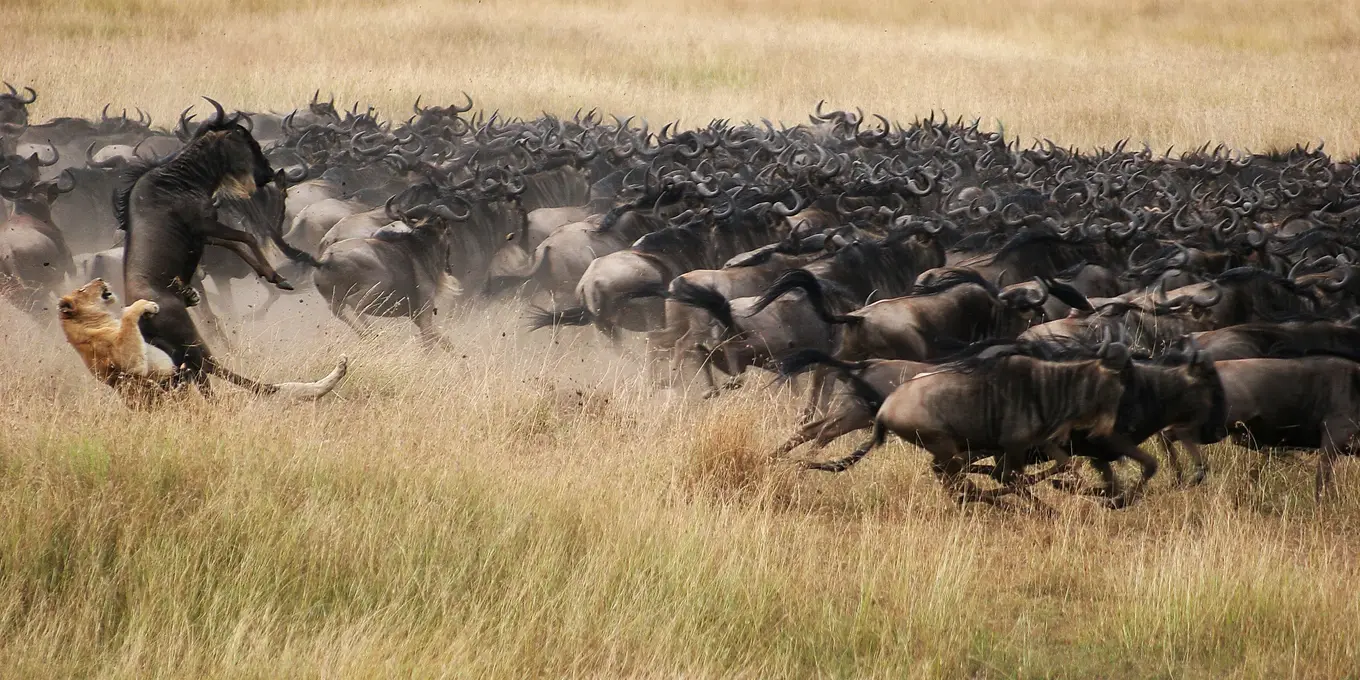
The Seasons of the Great Migration
You can witness the Great Migration at any time of the year. The herds follow the rains and fresh grass, which means their movements can be guessed from past patterns. But remember – these are wild animals, and nature is never fully predictable. With changing rainfall, the journey of the herds is becoming more surprising and exciting each year.
January – March: Calving Season on the Serengeti
From December to March, the great wildebeest herds gather on the southern plains of the Serengeti and in the Ngorongoro Conservation Area. These lands are covered in fresh, green grass—the perfect food for the herds and the perfect place for new life to begin.
- December & January – The southern plains are lush and green. Around Ndutu and northern Ngorongoro, the wildebeest enjoy rich grazing as they prepare for the birth of thousands of calves.
- February – This is the heart of the calving season. In just two to three weeks, more than half a million-baby wildebeest are born—up to 8,000 calves each day! The open plains are suddenly filled with newborns, but this also attracts predators like lions, cheetahs, and hyenas looking for easy prey.
- March – The herds are still in the south, but the grass is starting to dry. Soon, the wildebeest will begin their great journey north in search of fresh pastures.
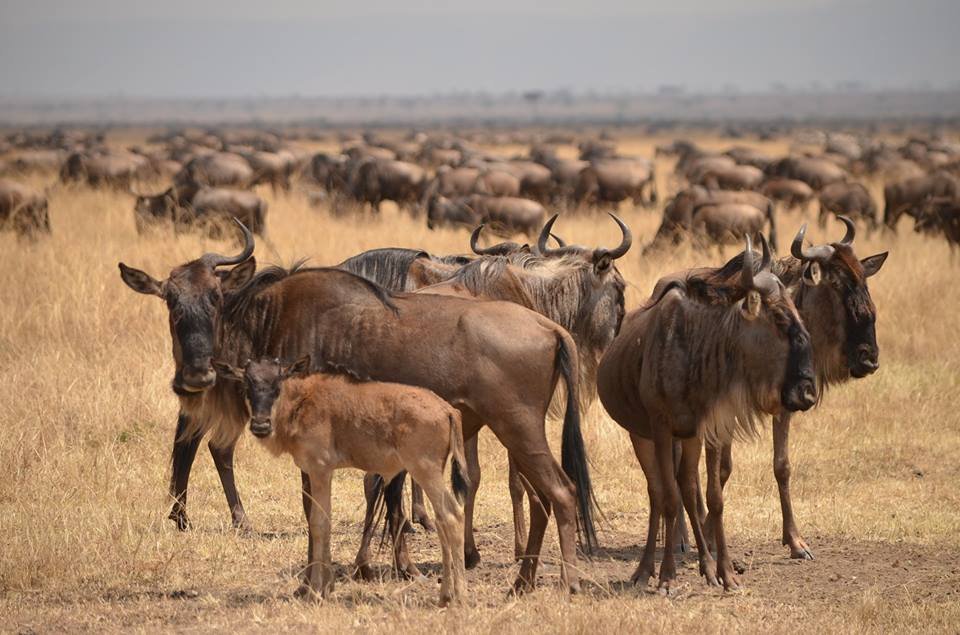
April to Mid-June: The Trek North and the Rut
From December to March, the great wildebeest herds gather on the southern plains of the Serengeti and in the Ngorongoro Conservation Area. These lands are covered in fresh, green grass—the perfect food for the herds and the perfect place for new life to begin.
- December & January – The southern plains are lush and green. Around Ndutu and northern Ngorongoro, the wildebeest enjoy rich grazing as they prepare for the birth of thousands of calves.
- February – This is the heart of the calving season. In just two to three weeks, more than half a million-baby wildebeest are born—up to 8,000 calves each day! The open plains are suddenly filled with newborns, but this also attracts predators like lions, cheetahs, and hyenas looking for easy prey.
- March – The herds are still in the south, but the grass is starting to dry. Soon, the wildebeest will begin their great journey north in search of fresh pastures.
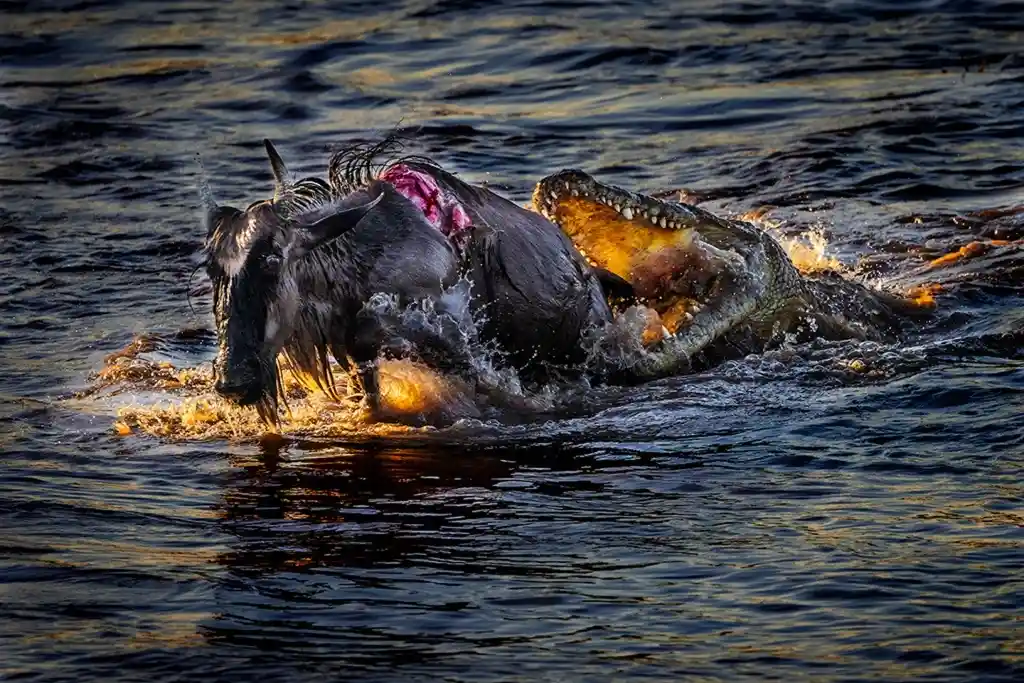
Mid-June to November: The Great River Crossings
By mid-year, the herds push further north, driven by the search for fresh grass. This is the most dramatic time of the Great Migration—the famous river crossings. Timing depends on the rains, but from July onward, wildebeest gather in the north to face their greatest challenge: the crocodile-filled rivers of the Serengeti and Masai Mara.
- July – The migration gathers speed. Vast herds fill the Western Corridor and begin arriving in the Northern Serengeti. The first river crossings often begin here, thrilling and terrifying to witness.
- August – The Great Mara River becomes the stage for chaos. Thousands of wildebeest plunge into the strong currents, battling crocodiles and the rushing water. Many don’t survive, but the herds push on—strengthened by the sheer number of calves born earlier in the year.
- September – The bulk of the migration is now in Kenya’s Masai Mara, though some herds remain in the Serengeti. Across the open plains, the wildlife spectacle reaches its peak.
- October – As the herds turn southward, they must brave the Mara River once more. The crossings are just as dangerous, but the instinct to move on is unstoppable.
- November – The short rains arrive, turning the southern Serengeti green again. The wildebeest surge back down, drawn to the fresh grass. By December, many reach Ndutu—ready for the calving season, and the cycle begins anew.
December: The Calving Season Begins
By December, the wildebeest herds return to the southern plains of the Serengeti and the northern edges of the Ngorongoro Conservation Area. The land is green and full of sweet grass, the perfect place for the mothers-to-be. Here, the wildebeest rest and feed, preparing for the arrival of their calves.
- December & January – The plains around Ndutu and northern Ngorongoro burst with life. The herds spread out across the lush grasslands, grazing and gathering strength before the great wave of births begins in February.
The Great Migration: Month By Month
Learn more below about historical patterns that predict where the Great Migration is each month:
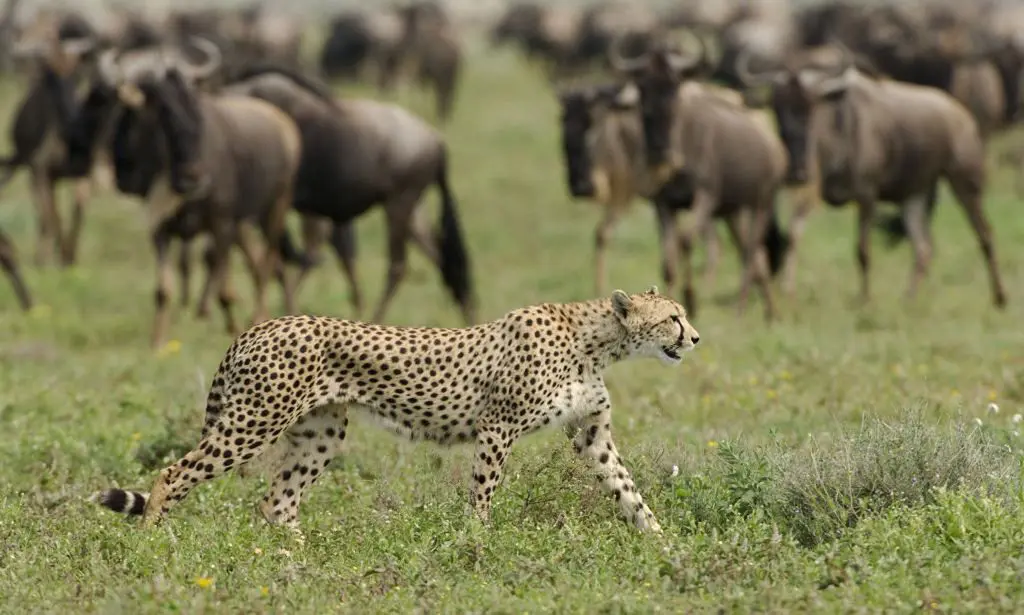
January – Gathering on the Southern Plains
The wildebeest begin to congregate on the short grass plains of the southern Serengeti, stretching from Moru south to Naabi, Kusini, and Ndutu. These plains are rich in minerals like phosphorus and magnesium, thanks to volcanic ash, making them perfect for mothers preparing to calve. Expect dramatic afternoon thunderstorms, lush green landscapes, and large numbers of zebra and gazelle mixed among the wildebeest. With some luck, you might even spot the very first calves of the season.
February – Peak of the Calving Season
This is the most magical month of the migration. Over half a million wildebeest calves are born in just a few weeks, often up to 8,000 a day. The spectacle stretches from Ndutu and Kusini to the Ngorongoro Highlands. Predators take full advantage—cheetahs, lions, leopards, and hyenas hunt the vulnerable newborns, creating incredible predator-prey interactions. This is also the driest month of the rainy season, with only light, scattered showers. It’s one of the very best times to see the Serengeti come alive with new life.
March – Calving Season Winds Down
The final calves are born, and the herds remain mostly in Ndutu and Kusini, though some push south into Maswa or east toward the Namiri Plains. This area is famous for big cats, so sightings of cheetahs chasing young wildebeest are common. The rains grow heavier, painting the landscape emerald green, while dramatic skies provide stunning photo opportunities. This is still a very predator-rich time of year.
April – Preparing to Move North
The herds are still concentrated in the south and central Serengeti, making the most of the nutritious short grasses. This is your last chance to see the migration massed together before they scatter on their long trek north. The first signs of restlessness appear as the grass quality declines. Heavy rains and afternoon thunderstorms are frequent, creating moody skies and lush backdrops.
May – The Trek Begins
The wildebeest are now on the move, stretching into long columns as they head north through Moru Kopjes and toward the Western Corridor. Massive groups may stretch for kilometers, an unforgettable sight. The grasses here are taller and less nutritious, pushing the herds to keep moving. Late-season thunderstorms provide water, and the wildebeest mix with zebra, buffalo, and giraffe along the way. This is one of the best months for seeing the sheer scale of the migration.
June – The Rut and First River Crossings
The herds funnel into the Western Corridor and Grumeti Reserve. It’s the peak of the rutting season—male wildebeest fight in noisy, dramatic clashes for the chance to mate. The Grumeti River, home to massive Nile crocodiles, becomes the first major obstacle. Some herds risk early crossings, and many wildebeest are lost to the predators. The dry season begins, though scattered showers still linger in the north. Expect explosive predator action and the start of high drama.
July – The Northern Push
By now, the leading herds have reached the northern Serengeti near Kogatende. This is the beginning of the legendary Mara River crossings. Thousands of wildebeest plunge into crocodile-infested waters while others hesitate nervously on the banks. The crossings can happen at any time, often more than once a day, making July one of the most thrilling months to visit. Predators—both in the water and on land—are everywhere, ensuring nonstop action.
August – Drama at the Mara River
This is peak river-crossing season. Vast herds crowd the riverbanks before surging across in dangerous, chaotic waves. Some cross north into Kenya’s Masai Mara, while others remain in Tanzania. The Lamai Wedge and Nyamalumbwa Plains are excellent places to watch enormous concentrations of animals. It’s not just wildebeest—you’ll also see zebra, topi, and gazelle mixed into the herds, all braving the rivers together. The crossings are deadly, but the herds keep moving forward.
September – In the Masai Mara
By now, most of the migration is grazing in Kenya’s Masai Mara, though some herds remain in northern Serengeti. River crossings continue in both directions, as the animals chase fresh grass wherever it grows. The dry season is at its peak, and food is scarcer, so predator activity is intense. Lions and cheetahs thrive in the Mara during this time, and dramatic hunts are often seen.
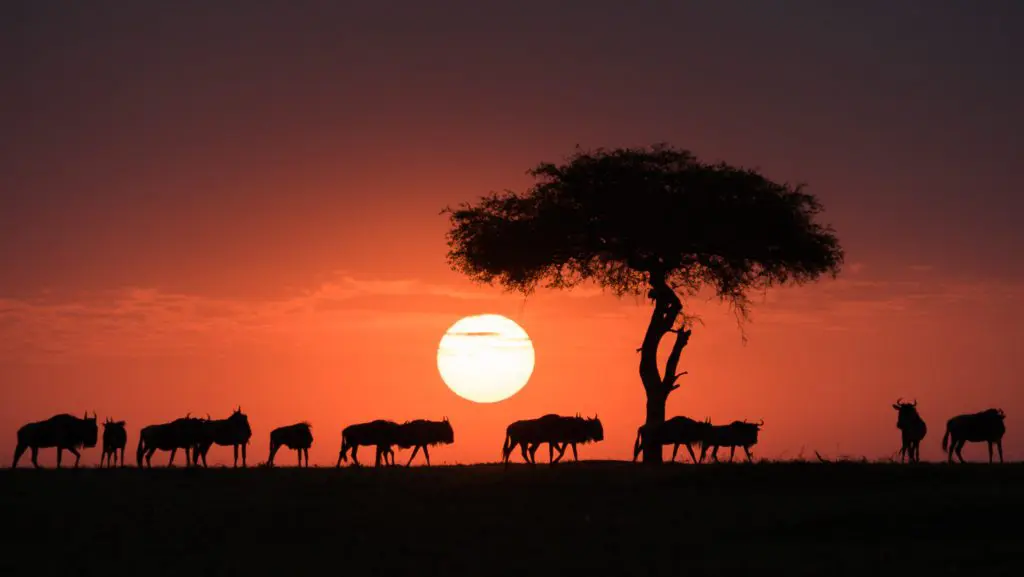
October – The Journey South Begins Again
The tail-end herds are still crossing back into Tanzania, while thunderstorms begin in the north. The main body of the migration is moving through the Lobo Valley and Grumeti Reserve, beginning the long trek south. This is the beginning of their return journey to the southern plains, completing the great circle. The mix of stormy skies, predators, and moving herds makes for incredible photography.
November – Short Rains and Southward Movement
The short rains arrive, refreshing the central Serengeti and drawing the herds southward. By now, most wildebeest have left the Mara and are streaming down through Lobo into the Seronera region. Grass is less nutritious here, but zebra and wildebeest coexist by eating different parts of the same plants. Expect scattered groups of wildebeest stretching for miles as they march steadily back to the south.
December – Returning to the Calving Grounds
The rains transform the southern Serengeti plains into a green paradise once again. The herds spread out from Lobo to Ndutu, feeding on the highly nutritious grasses that will sustain them through calving. Thunderstorms are common, but the lush scenery and abundance of animals more than make up for the rain. By late December, the wildebeest are firmly back on the southern plains, ready to begin the cycle all over again with the next great calving season.
Our Trusted Partners






